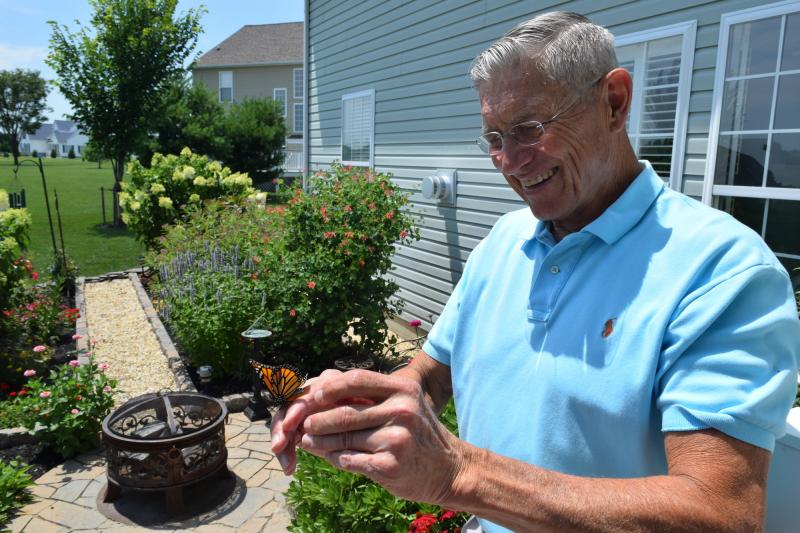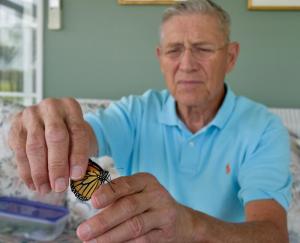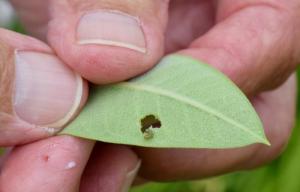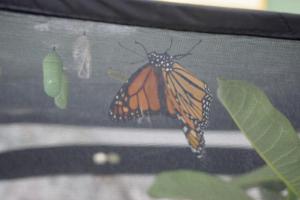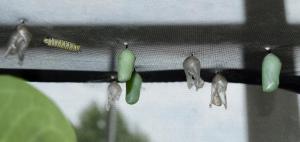An Army colonel now enjoying retirement in Sussex County is on a mission.
The objective: To save and protect monarchs in southern Delaware.
Michael McFarlin has spent the last six years raising and releasing wild monarch caterpillars and butterflies to give local populations a leg up.
“I'm not a scientist. I just like them,” McFarlin said as he showcased a handful of eggs, larvae, caterpillars and butterflies in his home off Oyster Rocks Road in Milton. He estimates the insects he collects have a 95 percent survival rate, compared to the 5 percent survival rate of those fending for themselves in the wild.
“Only the strong survive in the wild,” he said. “The only larvae that I deal with are those I've gotten from the wild, and if they weren't supposed to make it, they'll die.”
Growing up in Minnesota, McFarlin said, monarch butterflies were akin to mosquitos – having a car grille plastered with orange-and-black wings was pretty normal.
A decades-long career with the U.S. Army working on transportation logistics around the world – with half of his career spent in Germany – gave McFarlin other things to focus on. He said he temporarily forgot about the monarchs he had taken for granted as a young man.
When he retired from the Army to Virginia, he was surprised at the lack of monarchs. A little research revealed the far-ranging butterflies were in trouble – development, excessive mowing and the desire to have perfectly manicured lawns were ridding natural habitats of milkweed, which is monarch caterpillars' sole food source.
“There will always be monarchs - it's the migrating monarch we're concerned with,” he explained. “In the '90s, we had just under a billion. Now we're down to millions. In 2013, we went to the lowest number of monarchs we ever had. We just about lost the population. We're starting to come back, but we're still not really safe if we don't continue to do something we could lose the migrating monarch.”
McFarlin said their decline is due mostly to the reduction of milkweed throughout the United States. He said some estimates show native milkweed sources have dropped by 80 percent.
Learning about the monarch's plight prompted McFarlin to start searching for wild caterpillars.
By collecting monarch eggs and larvae, McFarlin protects future generations from the perils of mowing, as well as predators such as ants and spiders, as the tiny caterpillars form their golden-spotted chrysalides and emerge as butterflies.
Since he and his wife, Susan, moved to Delaware in 2013, they've continued their mission to save monarchs.
He's recently reached out to the Delaware Department of Transportation to start a pilot program that supports the state agency's Enhancing Delaware's Highways program that supports unmowed, pollinator-friendly roadside spaces. McFarlin has identified half a dozen areas in DelDOT's rights of way that are ideal habitat for monarchs: fallow and filled with milkweed.
“I think it's a good idea that he has here,” said Darin Callaway, a roadside environmental administrator with DelDOT, who is supporting McFarlin's efforts by allowing him to visit and study the sites, which will not be mowed by DelDOT.
“It's not that I'm against Delaware mowing, but this is the prime time for laying of eggs and for the caterpillars to be moving into the butterfly stage,” McFarlin said. “The problem is they mow the milkweed.”
Each of the rights of way set aside for milkweed growth is in Sussex County, and range from 50- to 100-feet long. The sites also are identified with signs that show the areas are set aside as monarch-friendly habitats, and volunteers will collect data about eggs and larvae and also clean trash from the sites. Abbott's Mill Nature Center also is participating in the pilot project, McFarlin said.
“Mike's taken the lead on supporting monarch butterflies, but as a secondary benefit, there's other pollinators that also utilize these same plots,” Callaway added.
McFarlin said he hopes having visible areas set aside along Sussex County highways also will help raise awareness.
“I know milkweed is a weed, but there's different kinds that can be planted in gardens and saved,” he said. “We're just trying to set aside areas that hopefully will produce some monarchs. They're small, but it's also about public awareness.”
- Monarchs only lay eggs on milkweed, which provides larger caterpillars and butterflies with a toxicity that deters predators.
- Monarch caterpillars only eat milkweed, while the butterflies can eat nectar from any flowering plant.
- There are more than 100 species of milkweed in the United States.
- Male butterflies have a black spot on each hind wing. Females do not.
- Once an egg hatches, it takes a little over two weeks for the caterpillar to mature and form a chrysalis. The insect is in a chrysalis for 12-16 days before it emerges as a butterfly. The butterflies live for about one month. Migrating monarch species can live up to 9 months.
- Monarchs can fly up to 2 miles high.
- Migrating monarchs travel from southern Canada and the northern United States in the late summer or fall to Mexico, while the return journey takes place in the spring. It takes three or four generations of butterflies to make the journey.














